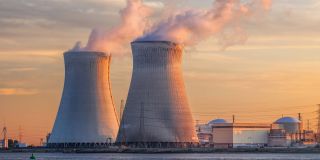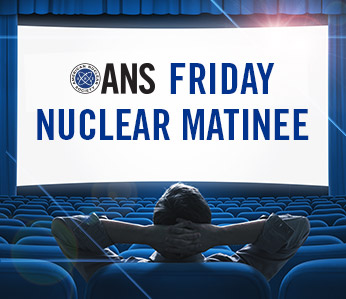A look at refueling in the COVID-19 era
According to the federal government, certain critical infrastructure industries have a special responsibility during the coronavirus pandemic to continue operations, including the nuclear power industry.

A message from Goodway
Dry Ice Blasting: A Game-Changer for Safe Cleaning and Decontamination in Nuclear Power Plants
According to the federal government, certain critical infrastructure industries have a special responsibility during the coronavirus pandemic to continue operations, including the nuclear power industry.
Four of six Illinois nuclear power plants—Braidwood, Byron, LaSalle, and Quad Cities—set operational records while conducting spring refueling outages amid the COVID-19 pandemic.
Performance records include the shortest refueling outage (18 days) at LaSalle; the shortest refueling outage at Quad Cities (16 days), as well as the completion of the site’s longest continuous run (722 days); and the completion at both Braidwood and Byron of their sixth consecutive continuous cycle of operations, also known as a “breaker-to-breaker” run, according to a May 7 press release from Exelon Generation. Exelon’s average outage duration in Illinois this spring was 17 days, a full two weeks shorter than the national average, the release stated.
The ANS Standards Committee has just published ANSI/ANS-2.8-2019, “Probabilistic Evaluation of External Flood Hazards for Nuclear Facilities.” The new standard supersedes ANS-2.8-1992, which was withdrawn in 2002.
The Nuclear Regulatory Commission is requesting comments on its draft environmental impact statement (EIS) for Interim Storage Partners’ (ISP) proposed consolidated interim storage facility (CISF) for spent nuclear fuel and greater-than-Class C (GTCC) waste in West Texas. The NRC published notice of the draft EIS in the May 8 Federal Register with a deadline of September 4 to submit comments. The NRC said that it is extending the usual 60-day comment period to allow more time for members of the public to submit comments during the COVID-19 health emergency.
Comments can be submitted through the federal rulemaking website with a search for Docket ID NRC–2016–0231.

Our matinee feature this week is a film produced by Argonne National Laboratory, entitled "Chicago Pile 1: The Day Tomorrow Began." This is the film history, from the official source, of the effort to design, construct and operate what became the first chain-reacting atomic pile in history.
 The ANS Young Members Group (YMG) is delivering an in-depth look at the Department of Energy’s national laboratories through a series of live webinars called Spotlight on National Labs. The third and most recent webinar attracted more than 1,000 participants who were keen to learn about the mission and key projects of Los Alamos National Laboratory.
The ANS Young Members Group (YMG) is delivering an in-depth look at the Department of Energy’s national laboratories through a series of live webinars called Spotlight on National Labs. The third and most recent webinar attracted more than 1,000 participants who were keen to learn about the mission and key projects of Los Alamos National Laboratory.
The ACRS supports subsequent license renewal for the Dominion units. Photo: Dominion Energy
The Nuclear Regulatory Commission’s Advisory Committee on Reactor Safeguards (ACRS) has issued a report recommending approval of Dominion Energy’s 20-year subsequent license renewal (SLR) application for Surry-1 and -2. The board reached its conclusion during its April meeting, after reviewing both the SLR application and the associated final safety evaluation report. Dominion submitted the application in October 2018.
A request to the Nuclear Regulatory Commission that it suspend all rulemakings and other activities involving public comment or participation has failed to receive the petitioners’ desired response from the agency.
In a letter dated April 8, representatives of 82 largely antinuclear organizations—including Beyond Nuclear, the Natural Resources Defense Council, the Nuclear Information and Resource Service, Public Citizen, and the Sierra Club—argue that the public’s role in NRC rulemaking and licensing decisions is not being properly protected during the coronavirus pandemic.

Birol
Nuclear energy demand and output could be reduced by 2.5 percent this year compared with 2019, according to the report Global Energy Review 2020 from the International Energy Agency (IEA). The report states that global nuclear power generation fell by about 3 percent in the first quarter of 2020 compared with the same period in 2019, adding that the decline was due to lower electricity demand as well as delays for planned maintenance and construction of several projects.
The Nuclear Regulatory Commission is developing a generic environmental impact statement (GEIS) for small-scale advanced reactor designs. Just how small a reactor must be to fit the parameters of the GEIS is one topic open for public comment, but the NRC staff anticipates including reactors generating up to 30 MWt. The public comment period is open until June 30

Robert Feitel, speaking at his December 3, 2019, nomination hearing before the Senate Environment and Public Works Committee’s Subcommittee on Clean Air and Nuclear Safety.
The Senate voted unanimously 87–0 on May 4 to confirm Robert Feitel as the inspector general of the Nuclear Regulatory Commission. The position had been vacant since the end of 2018, when the NRC’s longtime IG Hubert T. Bell retired.
A Department of Justice attorney, Feitel was nominated for the job by President Trump in October last year, and in December he was approved by the Senate’s Environment and Public Works Committee, also by unanimous vote.
When it comes to advanced, high-temperature reactors—using working fluids such as molten salt, high-temperature gases, or sodium—there simply are not many qualified materials for nuclear component construction. Alloy 617 is not a new material, but it made the news after Idaho National Laboratory announced that it was recently added to the American Society of Mechanical Engineers (ASME) Boiler and Pressure Vessel (BPV) Code for high-temperature nuclear applications, bringing the total number of qualified high-temperature materials to six.

By Paul Rochus , MarShield
Lead lined cabinets are utilized across a wide variety of industries including hospitals, nuclear medicine and the nuclear power industry. Some of the applications of shielded cabinets are for storing radioisotopes, radioactive waste, and providing shielding while operating x-ray tubes and protecting sensitive electronic devices from external radiation damage.

A rendering of Phase 1 of ISP’s proposed consolidated interim storage facility in Andrews County, Texas. Image: WCS
The Nuclear Regulatory Commission has released a draft environmental impact statement (EIS) for Interim Storage Partners’ (ISP) proposed consolidated interim storage facility (CISF) for spent nuclear fuel and greater-than-Class C (GTCC) waste in West Texas. Based on its environmental review of the CISF, the NRC staff issued a preliminary recommendation that an NRC license be granted to ISP to construct and operate the CISF to temporarily store up to 5,000 metric tons of uranium (MTU) in commercial spent fuel and GTCC waste for a licensing period of 40 years.

The Vogtle-3 containment vessel in March. Photo: Georgia Power
Despite its recent decision to trim the workforce at the Vogtle reactor construction project by about 20 percent to better address the COVID-19 pandemic, Southern Company is confident that Units 3 and 4—twin AP 1000 pressurized water reactors—will be up and running according to schedule.
Belgium’s National Institute of Radioelements (IRE) announced on April 30 that it has produced its first batch of commercial molybdenum-99 from low-enriched uranium (LEU) targets. The first batch of Mo-99, whose decay product, technetium-99m, is used in nuclear medicine for diagnostic imaging, was produced for the U.S. health market. IRE said that the conversion to LEU represents a key milestone for the institute in the global commitment to end the civilian use of highly enriched uranium (HEU) for the production of Mo-99.
A Michigan antinuclear group will have an opportunity next month to explain to an Atomic Safety and Licensing Board why there should be a public hearing on a license amendment request (LAR) concerning the fuel racks used in the Fermi-2 spent fuel pool (SFP).
 The latest season of Amazon’s detective series Bosch premiered recently on its streaming service, Prime. The season opens with the murder of a medical physicist and the theft of radioactive cesium, with plenty of drama following as the protagonist tries to solve the murder and end the “catastrophic threat to Los Angeles.” The show is a work of fiction, but let’s take a closer look at the depiction of radiation to sort out the scientific facts.
The latest season of Amazon’s detective series Bosch premiered recently on its streaming service, Prime. The season opens with the murder of a medical physicist and the theft of radioactive cesium, with plenty of drama following as the protagonist tries to solve the murder and end the “catastrophic threat to Los Angeles.” The show is a work of fiction, but let’s take a closer look at the depiction of radiation to sort out the scientific facts.
The setup: The series stars Titus Welliver as Los Angeles Police Department detective Harry Bosch and Jamie Hector as his partner, Jerry Edgar. The first episode of the sixth and latest season begins late in the evening at a Los Angeles hospital. We are shown a nervous-looking medical physicist as he walks into a laboratory, the camera dramatically focusing on the radiation sign on the door. No one else is around as the medical physicist clears out the lab’s inventory of what we find out later is cesium. The physicist then walks the material out of the hospital without anyone giving him a second look.

ITER vacuum vessel section no. 6, shown here, was completely assembled in April. South Korea is providing four of the nine 40-degree vacuum vessel sections; Europe is providing the other five. Photo: ITER
South Korea’s Hyundai Heavy Industries (HHI) has completed work on the first vacuum vessel section for the International Thermonuclear Experimental Reactor (ITER), the ITER Organization reported on April 28. The 440-ton section is now being prepared for shipping this summer to the ITER construction site, located near Saint-Paul-lez-Durance, France.
 The ANS Young Members Group (YMG) is offering a series of live webinars—Spotlight on National Labs—to highlight the missions, key projects, and rising stars of the Department of Energy’s national laboratories. Recently it was Argonne National Laboratory’s turn to shine.
The ANS Young Members Group (YMG) is offering a series of live webinars—Spotlight on National Labs—to highlight the missions, key projects, and rising stars of the Department of Energy’s national laboratories. Recently it was Argonne National Laboratory’s turn to shine.